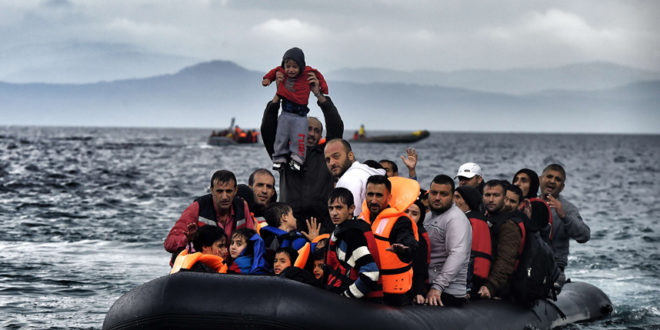Deaths in Mediterranean have risen with migrants opting for dangerous routes and exposing themselves to violence, says IOM
The Guardian
11 September, 2017
Saeed Kamali Dehghan
More than 22,500 migrants have reportedly died or disappeared globally since 2014 – more than half of them perishing while attempting to cross the Mediterranean, according to a study by the International Organisation for Migration (IOM).
A clampdown on Europe’s eastern borders has forced migrants to choose more dangerous routes as the death toll in the Mediterranean continues to rise despite a drop in the overall number of arrivals, data compiled by the UN refugee agency shows.
“While overall numbers of migrants attempting to cross the Mediterranean by the eastern route were reduced significantly in 2016 by the EU-Turkey deal, death rates have increased to 2.1 per 100 in 2017, relative to 1.2 in 2016,” reads the IOM report which is released on Monday. “Part of this rise is due to the greater proportion of migrants now taking the most dangerous route – that across the central Mediterranean – such that 1 in 49 migrants now died on this route in 2016.”
Since 2014, more deaths have been documented on this route than any other migration route in the world. In the first half of this year, the IOM said at least 3,110 migrants have died or disappeared globally, which is lower than the figure in 2016 (4,348), but the risk of dying has increased in the Mediterranean even though fewer migrants crossed into Europe.
“The central Mediterranean route, ending at Lampedusa or the main island of Sicily, accounts only for about a quarter of almost 1.5 million people who have arrived since 2014 on all routes, but for 88% of all migrant deaths in the Mediterranean,” it said.
Last month, Amnesty International criticised Italy for taking measures to keep migrants away from its shores, which it said leads “in their arbitrary detention in centres where they are at almost certain risk of torture, rape and even of being killed”. The IOM’s report also complained about smugglers in Libya and Italy increasingly using less seaworthy vessels.
Jean-Guy Vataux, head of mission in Libya for Médecins Sans Frontières, told the Guardian nearly all the people rescued from drowning in the Mediterranean have been “exposed to an alarming level of violence and exploitation: kidnap for ransom, forced labour, sexual violence and enforced prostitution, being kept in captivity or detained arbitrarily”.
According to Vataux, the majority of migrants in Libya live clandestinely “under the yoke of smugglers or – for the most unlucky – kidnapping organisations”.
He added: “Migrants going through Libya to reach Europe are facing impossible choices: getting on a boat is very risky, many die before they reach the European coast or a rescue ship. Remaining in Libya, whether in detention centres run by the administration or a criminal organisation, exposes them to unbelievable levels of violence and exploitation. There needs to be other options made available very quickly, like safe passage to other Mediterranean countries.”
Restrictions on the eastern route meant the number of arrivals in countries such as Croatia, Serbia and Macedonia had dramatically dropped. The three countries, which are not a part of the EU border-free Schengen zone, restricted migrants’ access in late 2015.
In the first half of this year, at least seven migrants have died of hypothermia during the winter months in the western Balkans. The International Committee of the Red Cross (ICRC) has recently published a report warning of the dangers in the route. A mother and son who successfully crossed the Evros river – along the border between Turkey and Greece – both later died of hypothermia.
More than 120,000 people have arrived in Europe by sea so far this year – most departed from Libya bound for Italy, from Turkey bound for Greece or, more recently, from Morocco bound for Spain. About 82% of all migrants were travelling to Italy from Libya. In June, the Italian coastguard rescued about 5,000 people in one day in the Mediterranean.
The IOM report covers the period from January 2014 to the end of June and thus does not reflect the recent developments in Myanmar, where atrocities against the country’s Rohingya Muslim minority has led to an exodus of thousands to neighbouring Bangladesh.
The IOM report, titled Fatal Journeys, has been compiled by the Berlin-based Global Migration Data Analysis Centre (GMDAC). It is the only existing database on migrant deaths at the global level, collected through various means including official records, medical examiners and media reports.
Ann Singleton, senior research fellow at the University of Bristol’s school for policy studies, said: “For the families left behind it could make a real difference if they are able to find more information on their missing relatives. Better data on migrant fatalities can also help inform policies aimed at reducing migrant deaths.”
Global figures for the first half of 2017 show that northern Africa also had high fatalities and disappearances, with at least 225 recorded deaths. The majority of incidents occurred along routes from western Africa and the Horn of Africa towards Libya and Egypt. Sickness or violence are the main cause of death in those cases.
At least 150 deaths were also recorded in the US-Mexico border crossings since January. “Along the border, irregular migrants avoid coming into contact with authorities in well-patrolled areas and are often forced to cross natural hazards such as the desert of Arizona or the fast-running Rio Grande river,” IOM said. More people have died attempting to cross the border compared with last year despite an ease in border apprehensions of migrants.
Recent clampdowns on the Libya-Italy route have also led to the increase in attempts to reach the continent via Morocco. The IOM has said the number of people arriving in Spain by sea this year is likely to outnumber the number arriving in Greece.
Francesca Friz-Prguda, UNHCR representative in Spain, who recently visited the port cities of Tarifa and Algeciras, where refugees are arriving almost daily after crossing the strait of Gibraltar from Morocco, said Spain was underprepared and lacked an integrated national strategy. More than 14,000 migrants have arrived by sea – a 90% increase compared with last year. Arrivals in Andalusian ports have tripled.
“While this is really not an emergency situation if you compare it to Italy, there are no adequate structures and procedures in place to deal even with the current level, let alone with more arrivals,” she said.
“It’s a myth to assume that people arriving here are all economic migrants, sub-Saharan Africa is one of the most refugee-producing regions in the world, so even statistically there’s a likelihood that these mixed flows are refugees travelling,” she said. “A lot of media have not dealt with the issue in a very responsible way, talking about avalanches and storms, flood, and God knows what – there’s a clearly a perception which doesn’t seem to sufficiently understand that first there are many refugee-producing countries in sub-Saharan Africa.”
 Lebanese Ministry of Information
Lebanese Ministry of Information



